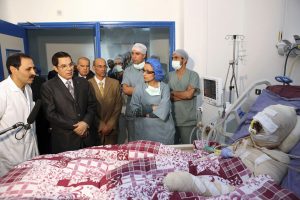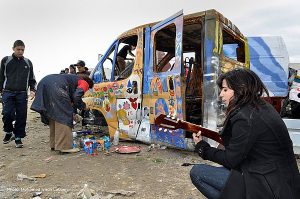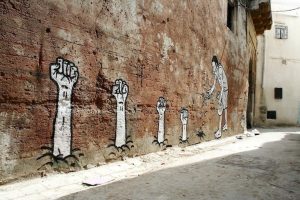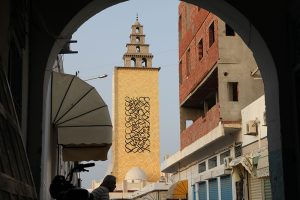The Arab Spring started with a spark — quite literally. In the city of Sidi Bouzid, a twenty-six year old was frustrated. He was the primary income earner for his large family of eight. Mohamed Bouazizi operated a produce cart within the city, and had since he was nineteen. On December 17, 2010, a police officer claimed that Bouazizi was in violation of local law and lacked a permit to operate his cart. Bouazizi was aware that his family depended on the wages he would make that day, and urgently tried to pay the fine that was the usual consequence of the violation. However, the officer who had alleged that Bouazizi was breaking the law, ridiculed him and refused to return his cart to him. Bouazizi went higher up, and attempted to consult the local municipality but no one was able to hear his pleas. With nowhere else to turn, Bouazizi soaked himself in paint thinner and lit himself on fire in the middle of the town square.
Bouazizi’s act of self immolation sent shockwaves throughout the globe. A wide number of Tunisians could resonate with Bouazizi’s frustrations. He was the textbook example of the struggles most young men faced not just in Tunisia, but across the Arab World. Bouazizi was young, he was male, he was working a grueling job for low wages, and had to provide for his extended family. There was no better job options available to Bouazizi–he would likely be stuck operating his produce cart for years on end.

As a result of his act of martyrdom, Tunisians took to the streets. Local police addressed the protests with violence, and video footage posted to social media platforms like YouTube and Twitter brought in a worldwide audience. Bouazizi did not die instantly from his protest. He passed away in a local hospital on January 4, 2011.
Other citizens looked toward Bouazizi as inspiration. On December 22, 2010, Lahseen Naji also protested the widespread unemployment throughout his home country and electrocuted himself. On that same day, Ramzi al-Abboudi also publicly took his own life to protest social issues within the country. These suicides were also followed by even more protests and public demonstrations. As tensions grew thicker and police began to use more force on those who took to the streets, the government issued a curfew on the city.
By December 27, the protestors had finally made their way to the capital of Tunis. Over a thousand citizens demanded to see positive social change being made. Security forces ultimately dissipated these demonstrations, but the Tunisians refused to stop there. Lawyers specifically led the protests that followed. The Tunisian National Lawyers Order and the Tunisian Human Rights League claimed that lawyers across the country had been victim to beatings and unjust imprisonment as a result of participation in the demonstrations. On January 6, over ninety-five percent of the over eight-thousand lawyers who practice in Tunisia went on strike. Another group that faced further targeting from security forces and police were bloggers. People who reported the protests–whether by reporting for national broadcasting agencies or by uploading videos to personal social media accounts-were arrested.
Prime Minister Zine al-Abidine Ben Ali
Ben Ali was no stranger to political hardship himself. He was born in 1936 to a middle class family in the rural area surrounding the Tunisian city of Sousse. He went abroad to receive his education, and studied in both France and in the United States. He returned interested in politics, and secured the position of ambassador to Poland in the 1980s. Soon enough, during a peaceful coup, Ben Ali became prime minister in 1987 after the removal of President Habib Bourguiba.
At first, the people of Tunisia had confidence that he would bring democracy to the country. That is what he had promised the people in numerous speeches. However, when the 1989 and 1994 elections rolled around, Ben Ali’s name was the only one on the ballot for prime minister. Holding elections with only one candidate to select from is not a form of fair and free elections, a necessity for democratic societies. Eventually, Ben Ali’s administration began to introduce other options in future elections, but it was clear who the front runner was. He even went as far as to rewrite the Tunisian Constitution in order to ensure that he was able to stay in office.
Generally speaking, Ben Ali did achieve a decent amount of social reform and positive policy for his country. Women made great strides toward equality. Tourism rates were at an all time high. The economy was growing. The thing that truly tarnished his reputation as a leader was the fact that there was seemingly no cure to rising unemployment rates, specifically among young people. Furthermore, the blatant inequality between classes, paired with the incredibly difficult process for college graduates to find work angered a large section of the population. However, before the Jasmine Revolution, the people avoided speaking out about what did not sit well with them. This is partially because public opposition and dissent was illegal in Tunisia. Ben Ali began to give himself a reputation by arresting individuals who spoke out against him and his policies and often refused to grant the prisoners fair trials–if they were even lucky to have a trial.
When Bouazizi lit himself on fire and Tunisia rallied in support of his cause, Ben Ali initially was outraged about the protests. He threatened severe punishment for those involved and claimed that there were “certain foreign television channels…broadcasting false allegations without verification, based on dramatization, fermentation and deformation by media hostile to Tunisia.” Despite his anti-demonstration rhetoric, Ben Ali must have felt some pressure as a result of the protests, because on December 29, 2010 he fired his Communications Minister Oussama Romdhani and declared that there would be alterations made to various political sectors, including those involved with trade and handicrafts, communication, youth and religious affairs. In the beginning of January 2011, Ben Ali once again spoke poorly about the protests, and described them as “the work of masked gangs that attacked at night government buildings and even civilians inside their homes in a terrorist act that cannot be overlooked.” Shortly after, he then closed all institutions of higher education and declared that he would not alter the constitution in its present form. On January 13, 2011, Ben Ali really began to worry. He passed an emergency law that forbid Tunisians from gathering in groups of three or more. If police, military, or security forces came upon these illegal groups, they faced arrest or being shot on sight. He attempted to smooth over this controversial move by announcing an election for prime minister to be held within six months, but it was of no use. The very next day, on January 14, Ben Ali and his family fled the country in search of asylum.
Art of Resistance

“Street Art in the Neighborhood” was a project completed by artist Faten Rouissi. She is from right outside of the capital city of Tunis. During some of the protests, cars were set on fire in acts of defiance. However, once the protests had ceased, the burnt out car husks just were rotting away in an empty lot. Rouissi decided to turn the car lot into a group street art exhibit. Artists from the location painted each car in a unique manner. Some of the cars were painted in patriotic colors, others were in gloomy colors. “Each car…represents agency, solidarity, and hope in the future of the revolutionary movement.”

This image is one of the most notorious murals from the revolution. It depicts the common image of fists breaking free from the ground. A man in regular clothing is near the fists, planting seeds. The fist is a common symbol in art of resistance, as it symbolizes the strength of the opposition. The mural is by an unknown artist, and was done with free hand paint without the assistance of stencils.
eL Seed
In the video above, eL Seed explains his “calligraffiti” style and his most recent project of spreading words of kindness, unity, and peace through small projects throughout Tunisia.
eL Seed is an artist who gained traction after the revolution. In his early thirties, eL Seed is best known for his grand murals of Arabic calligraphy, which he trademarks as “calligraffiti.” Right after the revolution began, he created a mural that had text that encouraged the protesters to continue to embody their message while also pursuing peace simultaneously. The wall that he had chosen to paint his mural upon had previously been a place where protesters had written messages to each other on the wall to spread the word about the revolution. The verse from the Quran that eL Seed chose to paint on the wall reads:
